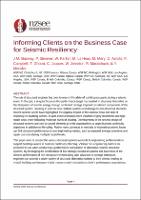| dc.description.abstract | The role of structural engineer has been to ensure life safety of building occupants during a seismic event. In the past, a singular focus on this performance target has resulted in structures that relied on the dissipation of seismic energy through controlled damage imposed on selected components of the structural system, resulting in safe but non-resilient systems and damage to non-structural elements. Recent seismic events have highlighted the negative impact of this narrow focus and lack of resiliency on building owners, as post-event recoveries have incurred lengthy downtimes and high repair costs, even following moderate levels of shaking. Recent developments in the design of seismic structural systems provide opportunities to target business continuity objectives in addition to life safety. Furthermore, advances in methods of estimating seismic losses can link structural performance to non-engineering metrics, such as expected average downtime and repair cost considering multiple hazard levels.
This paper aims to present the various discussion points available to engineering professionals to support building owners in business continuity planning. Various non-engineering metrics are presented to use when conducting a performance comparison of alternative seismic structural systems, and case study examples are used to illustrate the benefits of early client involvement when selecting an appropriate performance target. By leveraging the combination of low-damage structural systems with advances in damage estimation, engineers can provide a wider variety of structural alternative options to their clients, compared using relevant metrics, leading to overall building performance which is more closely tailored to a client’s performance expectations. | |

